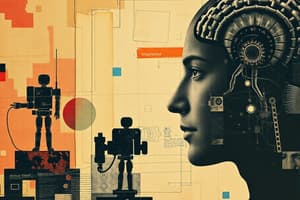Podcast
Questions and Answers
"The philosophical view that the mind and body (or brain) are fundamentally different substances" is known as ______.
"The philosophical view that the mind and body (or brain) are fundamentally different substances" is known as ______.
dualism
René ______ was a key proponent of Dualism, arguing that the mind is non-physical and separate from the material body.
René ______ was a key proponent of Dualism, arguing that the mind is non-physical and separate from the material body.
descartes
______ Naturalism argues that consciousness is a biological property of the brain.
______ Naturalism argues that consciousness is a biological property of the brain.
biological
______ functionalism is the idea that mental states are defined by their functional roles rather than their physical implementation
______ functionalism is the idea that mental states are defined by their functional roles rather than their physical implementation
______ Realizability is the idea that a particular mental function can be implemented in different physical substrates.
______ Realizability is the idea that a particular mental function can be implemented in different physical substrates.
The ______ Room Argument is a thought experiment against strong AI.
The ______ Room Argument is a thought experiment against strong AI.
The ______ Test evaluates a machine's ability to exhibit intelligent behavior indistinguishable from a human.
The ______ Test evaluates a machine's ability to exhibit intelligent behavior indistinguishable from a human.
The ______-knowledge tradeoff problem is one of the reasons why GOFAI failed.
The ______-knowledge tradeoff problem is one of the reasons why GOFAI failed.
According to Newell and Simon's hypothesis, any system manipulating symbols via rules can show general ______.
According to Newell and Simon's hypothesis, any system manipulating symbols via rules can show general ______.
[Blank]'s paradox highlights the difference in difficulty between high-level reasoning and low-level skills for AI.
[Blank]'s paradox highlights the difference in difficulty between high-level reasoning and low-level skills for AI.
The ______ Approximation Theorem states that a neural network with one hidden layer can approximate any continuous function.
The ______ Approximation Theorem states that a neural network with one hidden layer can approximate any continuous function.
In Reinforcement Learning, an agent learns to maximize long-term rewards by interacting with an ______.
In Reinforcement Learning, an agent learns to maximize long-term rewards by interacting with an ______.
[Blank] RL involves learning directly from trial and error without building a model of the environment.
[Blank] RL involves learning directly from trial and error without building a model of the environment.
The ______-Exploitation Tradeoff in RL requires balancing trying new actions vs. using known good actions.
The ______-Exploitation Tradeoff in RL requires balancing trying new actions vs. using known good actions.
[Blank] is the belief that complex systems can be understood by breaking them down into simpler parts.
[Blank] is the belief that complex systems can be understood by breaking them down into simpler parts.
The traditional AI approach that relies on explicitly programmed symbolic rules rather than learning from data is termed Good-Old-Fashioned ______ (GOFAI)
The traditional AI approach that relies on explicitly programmed symbolic rules rather than learning from data is termed Good-Old-Fashioned ______ (GOFAI)
The ______ Problem makes it hard for AI to determine which information is relevant in a given situation, making real-world decision-making difficult.
The ______ Problem makes it hard for AI to determine which information is relevant in a given situation, making real-world decision-making difficult.
The ______ Problem: Neural networks typically require thousands of examples, whereas humans can learn from just one or a few.
The ______ Problem: Neural networks typically require thousands of examples, whereas humans can learn from just one or a few.
Flashcards
Dualism
Dualism
Philosophical view that mind and body are different substances.
Biological Naturalism
Biological Naturalism
Theory claiming consciousness is a biological property like digestion.
Computational Functionalism
Computational Functionalism
Mental states defined by functional roles, not physical form.
Multiple Realizability
Multiple Realizability
Signup and view all the flashcards
Chinese Room Argument
Chinese Room Argument
Signup and view all the flashcards
Turing Test
Turing Test
Signup and view all the flashcards
GOFAI
GOFAI
Signup and view all the flashcards
Know-how Problem
Know-how Problem
Signup and view all the flashcards
Moravec’s Paradox
Moravec’s Paradox
Signup and view all the flashcards
Symbolic System
Symbolic System
Signup and view all the flashcards
Universal Approximation Theorem
Universal Approximation Theorem
Signup and view all the flashcards
One-Shot Learning Problem
One-Shot Learning Problem
Signup and view all the flashcards
Model-Free RL
Model-Free RL
Signup and view all the flashcards
Exploration-Exploitation Tradeoff
Exploration-Exploitation Tradeoff
Signup and view all the flashcards
Reductionism
Reductionism
Signup and view all the flashcards
Systems Level Reductionism
Systems Level Reductionism
Signup and view all the flashcards
Study Notes
L2: Can Computers Think?
- Dualism: Mind and body are fundamentally different substances (non-physical mind separate from the physical body). Descartes championed this view.
- Biological Naturalism: Consciousness is a biological property of the brain, similar to digestion. Computers can simulate, but not truly have, consciousness (Searle).
- Computational Functionalism: Mental states are defined by their functional roles; intelligence can be realized in multiple systems (including computers).
- Multiple Realizability: A mental function can be implemented in various physical substrates (brains, chips).
- Why Almost Any Computer Could Have Intelligence: Due to multiple realizability and computational functionalism, intelligence is not bound to the biological brain. Powerful computation systems could exhibit intelligent behavior.
- Chinese Room Argument: An AI can manipulate symbols without truly understanding their meaning. A person in a room following rules to respond to Chinese characters cannot understand Chinese. This argues against Strong AI (that an AI can understand).
- Turing Test: Evaluates a machine's ability to exhibit intelligent behavior indistinguishable from a human. Focuses on observable behavior, not internal processes. Powerful because of this focus.
L3: GOFAI / Symbolic Systems
- Symbolic System: Represents knowledge and reasoning using symbols (rules, logic). Example: Chess-playing AI using search trees.
- Symbolic System Hypothesis: Manipulating symbols according to rules can exhibit general intelligence (Newell & Simon).
- GOFAI (Good Old Fashioned AI): Traditional AI approach relying on explicitly programmed symbolic rules. Doesn't learn from data, unlike modern AI.
- GOFAI Failures (Three Reasons):
- Know-How Problem: Difficult to encode implicit human knowledge (e.g., riding a bike) as explicit rules.
- Speed-Knowledge Tradeoff: More knowledge = slower decision-making due to complex rule-based reasoning.
- Frame Problem: Difficulty determining which information is relevant in a particular situation, leading to problems in real-world decision-making.
- Moravec's Paradox: High-level reasoning (chess) is easier for AI, but low-level skills (walking, object recognition) are difficult.
L4: Connectionism
- Artificial Neuron: Mimics a biological neuron, receiving inputs, applying weights, summing and passing the result through an activation function (sigmoid, ReLU).
- Multi-Layer Perceptron (MLP): Multiple layers of neurons (input, hidden, output) for complex pattern recognition.
- Universal Approximation Theorem: MLP with at least one hidden layer can approximate any continuous function.
- Neural Network Challenges (Three):
- One-Shot Learning Problem: Neural networks usually need thousands of examples to learn, unlike humans who can learn with just a few.
- Curse of Universal Learners (Lack of Inductive Priors): Neural networks learn everything from scratch, unlike humans who use prior knowledge to generalize efficiently.
- Mirrors of Intelligence: AI systems may mimic intelligence without true understanding.
L5: Reinforcement Learning
- Basic Idea Behind RL: An agent learns by interacting with an environment and maximizing long-term rewards.
- Model-Free vs. Model-Based RL:
- Model-Free: Learns directly from trial and error without an environmental model.
- Model-Based: Builds an internal environment model to plan before acting.
- RL Challenges:
- Sparse Rewards: Environments with little reward make learning slow.
- Exploration-Exploitation Tradeoff: Balance trying new actions (exploration) vs. using known good actions (exploitation).
- Need a Training Ground: RL often requires simulated environments or expensive real-world interactions.
- Non-Stationarity: World changes, so current strategies may not work tomorrow.
- Alignment Problem: Ensuring AI goals align with human values.
L6: Bottom Up
- Why Study Human & Animal Intelligence?: Understanding biological intelligence inspires efficient AI architectures. Humans and animals have evolved effective problem-solving.
- Reductionism: Complex systems are understood by breaking them into simpler parts.
- Arguments for Reductionism:
- Scientific Field Success: Physics, chemistry, and biology have benefited from reductionism.
- Rich Explanations: Protects from overly broad or vague explanations.
- Types of Reductionism:
- Systems Level (Modularity): Breaking down intelligence into functional units (vision, memory).
- Neural Level: Understanding intelligence at the neuronal and synaptic connection level.
Studying That Suits You
Use AI to generate personalized quizzes and flashcards to suit your learning preferences.




